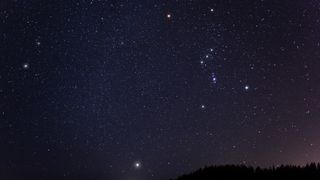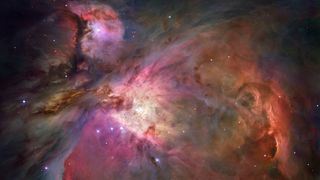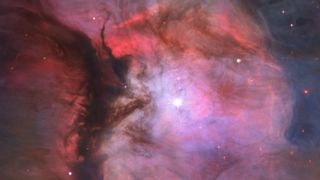Orion Constellation: Facts, location and stars of the hunter
The Orion Constellation is a familiar sight around the world.

Orion is located on the celestial equator and can be seen throughout the world.
The constellation is named after the hunter in Greek mythology is one of the most obvious and recognizable constellations in the sky.
Two of the ten brightest stars in the sky are located in Orion — Rigel (Beta Orionis) and Betelgeuse (Alpha Orionis), according to a stargazing website Astronomy Trek.
Where is Orion?

Orion is clearly visible in the night sky from November to February. Finding Orion's Belt is the easiest way to locate the Orion Constellation. Orion's Belt is formed by three bright stars; Alnilam, Mintaka and Alnitak. Orion is in the southwestern sky if you are in the Northern Hemisphere or the northwestern sky if you are in the Southern Hemisphere. It is best seen between latitudes 85 and minus 75 degrees. Its right ascension is 5 hours, and its declination is 5 degrees.
Betelgeuse, the second brightest star in Orion — according to the night sky guide website In-The-Sky.org, establishes the right shoulder of the hunter. Bellatrix serves as Orion's left shoulder. Other stars in the constellation include Hatsya, which establishes the tip of Orion's sword that hangs off the belt, and Meissa, which forms Orion's head. Saiph serves as Orion's right knee. Rigel, Orion's brightest star, forms the hunter's left knee.

With one exception, all of the main stars in Orion are bright young blue giants or supergiants, ranging in distance from Bellatrix (243 light-years) to Alnilam (1,360 light-years). The Orion Nebula is located around 1,350 light-years away from Earth. One light-year is the distance light travels in a single year, about 6 trillion miles (10 trillion kilometers).
The exception is the star Betelgeuse, which is a red giant and one of the largest stars known. Observers with a keen eye should be able to see the difference in color between Betelgeuse and all the other stars in Orion.
Orion observing targets
The Orion Constellation is home to many interesting stargazing targets, we explore a handful of them here. Though some of these targets can be seen with the naked eye, for a better view we recommend using binoculars or a telescope. If you need equipment, our best binoculars and best telescopes guides may help.
Jargon buster
Magnitude: An object's magnitude tells you how bright an object is as it appears from the Earth. In astronomy, magnitudes are represented on a numbered scale. Quite confusingly the lower the number, the bright the object. For example, an object of a -1 magnitude is brighter than one with a magnitude of +2.
Right ascension (RA): Right ascension is to the sky what longitude is to the surface of the Earth, corresponding to east and west directions. Measured in hours, minutes and seconds since, as Earth rotates, we see different parts of the sky through the night
Declination (Dec): Tells you how high your object will rise in the sky. Like Earth's latitude, declination measures north and south. Its units are degrees, arcminutes and arcseconds. There are 60 arcmins in a degree and 60 arcsecs in an arcmin.
Orion Nebula

Magnitude: +4.0
Approximate distance from Earth: 1,350 light-years
Location: 05h 35m 17.3s (right ascension), -05° 23' 28" (declination)
Casually glancing below the three stars of Orion's belt, you should be able to make out the Orion Nebula as a smudge in a dark, light pollution-free sky with your naked eye. The Orion Nebula — a formation of dust, hydrogen, helium and other ionized gases rather than a star — is the middle "star" in Orion's sword, which hangs off of Orion's Belt. It is one of the brightest nebulae in the sky, according to NASA.
Horsehead Nebula (Barnard 33)
Magnitude: 6.8
Approximate distance from Earth: 1,500 light-years
Location: 05h 40m 59.0s (right ascension), -02°27'30.0" (declination)
The Horsehead Nebula is a tricky target to find, but it is not impossible. The nebula can be found just south of the easternmost star in Orion's Belt. The shape of the nebula is forged by radiation from the surrounding stars. According to NASA, the nebula is only visible because the dust is silhouetted against a brighter nebula.
De Mairan's Nebula (Messier 43)

Magnitude: +9
Approximate distance from Earth: 1,600 light-years
Location: 5h 35.5m (right ascension), -5 16' (declination)
De Mairan's Nebula is only separated from the Orion Nebula by a dark lane of dust, according to NASA. The nebula was revealed to be a distinct nebula by French astronomer Jean-Jacques d'Ortous de Mairan in 1731. According to NASA, astronomers refer to De Mairan's Nebula as a miniature Orion Nebula, because of it's small size. The Nebula is shaped by just one star, whereas the Orion Nebula is shaped by four, according to NASA.
Trapezium Cluster
Magnitude: +4
Approximate distance from Earth: 1,600 light-years
Location: 05h 35.4m (right ascension) -05° 27' (declination)
The Trapezium Cluster is a young star cluster and contains hundreds of young stars at various staged of formation. According to ESA, high-speed jets of hot gas released by some young stars are sending shockwaves through the nebula at speeds of 100,000 mph. The cluster is easily located as the brightest four stars form the shape of a trapezoid.
Orion exoplanet possibilities
The constellation of the hunter has also proven a fertile hunting ground for extra-solar planets, or exoplanets, planets beyond the solar system. Here are a few of the planets (or potential planets) that have been discovered in stars that fall within Orion's boundaries in the Earth's sky.
The star CVSO 30 is 1,200 light-years away and likely hosts a couple of potential planets. In 2012, the Very Large Telescope in Chile managed to image possible exoplanet CVSO 30c directly, an incredible feat given that CVSO 30 is roughly 280 times farther than Earth is to the nearest star system (Alpha Centauri). CVSO 30c (if it exists) is a gas giant that orbits its star at a distance of 660 astronomical units (Earth-sun distances) and makes an orbit every 27,000 years. The other candidate planet is gas giant CVSO 30b, which by contrast is extremely close — just 0.008 AU from its star.
A Jupiter-size potential exoplanet, PTFO8-8695b, is about 1,100 light-years from Earth and (if it exists) is so close to its star that its outer layers are being ripped away from the rest of the planet. The star's system showed high-energy hydrogen emissions that can't be explained by stellar activities or features, according to astronomers.
There are a few other probable planets in Orion as well, although their existence may be proved or disproved with more observations. These include HD 38529 b and HD 38529 c (two gas giants orbiting in a system with a huge debris disk), HD 38858 b (a gas giant orbiting in the habitable zone of its star) and HD 37605 b (a gas giant that orbits extremely close to its parent star.)
Mythology
In Greek mythology, Orion was a hunter. According to greekmythology.com, there are several stories about Orion's birth as well as his death. According to the oldest version, described on greekmythology.com Orion was the son of the god Poseidon and Euryale, daughter of King Minos of Crete.
Orion inherited the ability to walk on water from his father and made his way to the island of Chios. It was there that Orion drank too much and made sexual advances to Merope, the daughter of the local king. King Oenopion had Orion blinded and thrown off the island. Orion then made his way to the east where Helios — the sun god — restored his eyesight. Confident in his hunting abilities, Orion declared he would kill every animal in the world but Gaea — the goddess of the Earth — angered by Orion's claims, sent a scorpion to kill him.
Upon Orion's demise, Zeus turned him into a constellation, along with the scorpion that killed him. According to a constellation website constellation-guide.com, the scorpion (constellation Scorpius) and Orion were placed on opposite sides of the sky so that when Scorpius rises in the sky, Orion flees and sets below the horizon.
While the name Orion is steeped in Greek mythology, many cultures have been influenced by the story of this constellation. According to constellationguide.com, the three stars of Orion's Belt are known as Drie Konings (the three kings) or Drie Susters (the three sisters) in South Africa. In Spain and Latin America, the stars are called Las Tres Marías, or The Three Marys. Ancient Egyptians believed Orion's Belt was the resting place of the soul of the god Osiris, according to the Chandra X-ray Observatory.
Additional resources
- See how our view of Orion will change over the next 450,000 years with the European Space Agency.
- Embark on a journey through the Orion Nebula with NASA.
- Observe the Orion Constellation in infrared light with this impressive image on ESA's website.
Additional reporting by Elizabeth Howell, Space.com contributor.
Join our Space Forums to keep talking space on the latest missions, night sky and more! And if you have a news tip, correction or comment, let us know at: community@space.com.
Get the Space.com Newsletter
Breaking space news, the latest updates on rocket launches, skywatching events and more!
Kim Ann Zimmermann is a contributor to Space.com and sister site Live Science, writing mainly evergreen reference articles that provide background on myriad scientific topics, like the constellations, astronauts, climate, culture and medicine. Her work can also be found at Business News Daily and KM World. She holds a bachelor’s degree in communications from Glassboro State College.
